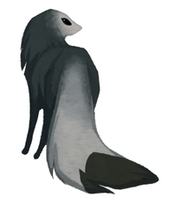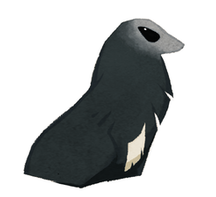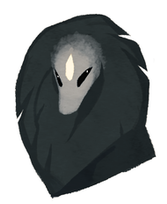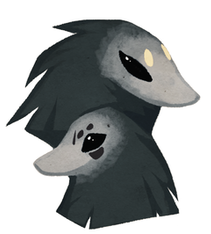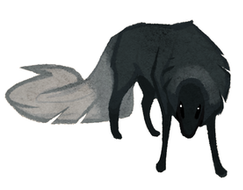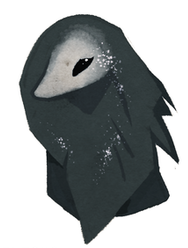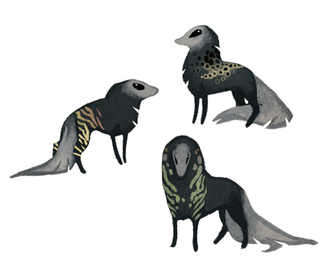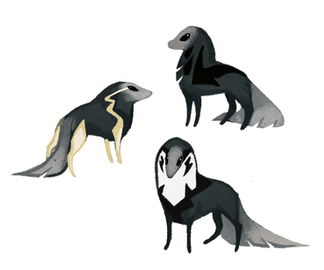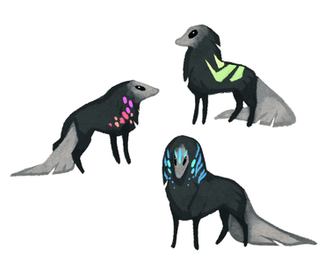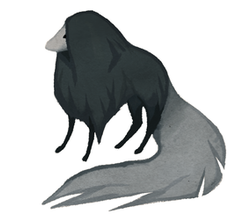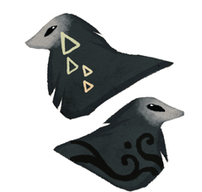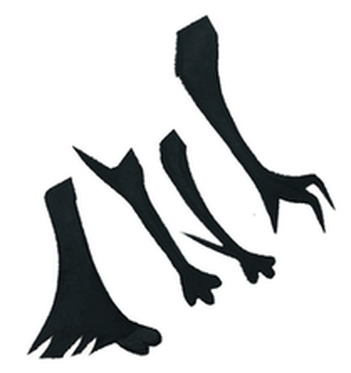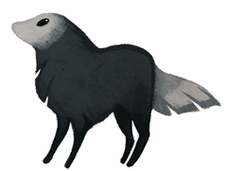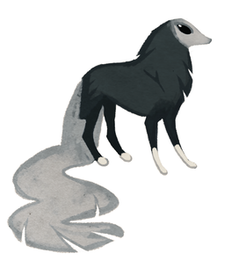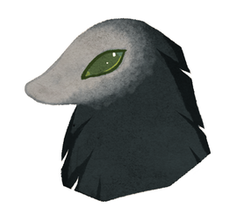Uncommon Traits
Some esk have more unusual markings and anatomy.
The traits described here are not available to common esk. They may be included in prizes or special MYO opportunities or they can be purchased in the Energy Exchange using Growth Points. The guidelines here will help you use these traits when designing new characters and modifications.
Uncommon traits are more frequently occurring and easier to obtain compared to rare traits, which are listed in another section of the guide.
Please read the detailed information here and use the visual guide to help you design your esk. A link to the visual guide is at the bottom of this page.
The traits described here are not available to common esk. They may be included in prizes or special MYO opportunities or they can be purchased in the Energy Exchange using Growth Points. The guidelines here will help you use these traits when designing new characters and modifications.
Uncommon traits are more frequently occurring and easier to obtain compared to rare traits, which are listed in another section of the guide.
Please read the detailed information here and use the visual guide to help you design your esk. A link to the visual guide is at the bottom of this page.
|
Tail tip marking
A tail tip marking is a defined marking at the tip of the tail or anywhere beyond the halfway point of the tail, including tail rings. The end of the tail can be a different color without it being a tail tip marking as long as it is a soft gradient that reaches the halfway point of the tail. common: Soft gradient reaching at least halfway up the tail, or a soft-edged tail tip that is very similar in color to the rest of the tail so as not to look like a clearly defined marking. uncommon: Contrasting color or tail ring somewhere beyond the halfway point of the tail with either a hard or soft edge. |
|
Chest marking
A chest marking is a defined marking in the chest area. Soft gradients that gradually fade into the body are considered common, but if there is enough contrast from the surrounding area a marking on the chest could be considered uncommon even with a soft edge. It depends on how strongly it stands out from the surrounding area. Chest markings can be a single shape or multiple spots or shapes. common: Soft gradient that reaches out to the body or neck. uncommon: Contrasting color or hard-edged marking in the chest region. A soft-edged marking can still be considered uncommon if it is in strong contrast with the surrounding area. |
|
Blaze
A blaze marking is a defined marking in the forehead area. Soft gradients that gradually fade into the rest of the face are considered common, but if there is enough contrast from the surrounding area a marking on the forehead could be considered uncommon even with a soft edge. It depends on how strongly it stands out from the surrounding area. A blaze is a single shape, if there are multiple spots or shapes around the face or eyes it will be considered the eyespots trait which is also uncommon. common: Soft gradient on the face. uncommon: Contrasting color or hard-edged marking on the forehead. |
|
Eyespots
Eyespots are any arrangement of spots or clearly defined shapes around the eyes. This includes tears, brows, and lines. A thin, colored ring or eyepatch around the eye does not count as an eyespot and is considered common. common: Soft gradients on the face, rings around the eye, or color patches over the eye. uncommon: Spots, tears, brows, lines, or other shaped markings around the eyes. |
|
Dark mask
Dark mask is when the face is darker than the majority of the body, is the darkest marking on the body, or is darker than the surrounding area. common: Same or lighter color than the surrounding area or body. Face only partially covered with dark color and not a complete mask (covers more than 50% of the face/head). uncommon: Dark colored mask relative to surrounding area or body. |
|
Flecks
Flecks are small glitter-like markings that glimmer like mica or stars. They can be anywhere on the body, face, or tail and can have a light or dark quality that sparkles in any color. Flecks are not simply small spots, they will always have a glimmering quality. Flecks can be applied to albino/solid color esk without voiding those traits. Flecks that cover more than 50% of the body are considered rare. common: All spots, dots, or freckles are uncommon (see below). uncommon: Glittering or sparkling quality to the markings. Flecks on 50% or less of the body. |
|
Stripes and Spots
Stripes or spots can appear in patches anywhere on the body. Spots and stripes can be combined. Stripes or spots that cover more than 50% of the body are considered rare. common: Soft gradients can have a spot or stripe pattern as long as they are very blurry. uncommon: Clearly defined stripes or spots on any part of the body. |
|
Bold Markings
Bold markings can be hard to define, but generally they are large, high-contrast markings that have a stark appearance on the body. Areas of white or black with hard edges are typically considered bold markings. Large dark areas against light areas, even with a softened edge, may be considered bold markings if they give the character a highly contrasted coloration. Bold markings that cover the body are considered uncommon, not rare. common: Dark and light markings that blend together gradually using large, soft gradients across the body. uncommon: Hard-edged contrasting markings, or stark black and white coloring. |
|
Bright Markings
Bright markings are high saturation markings occurring in one area of the body. Bright markings will stand out on the earthy, natural coloration of a normal esk and can be any color. Bright markings that cover more than 50% of the body are considered rare. common: Earthy or natural tones for markings. uncommon: Saturated colors like bright blues, bright pinks, etc |
|
Shaggy
The shaggy trait has specific requirements and does not mean that long-haired esk are uncommon. Esk can have various fur lengths but if the long fur obscures some parts of the body or creates an unusual silhouette then they require a shaggy trait. Fur that covers the face or legs is always considered shaggy. Shaggy fur that alters a silhouette is harder to define, but generally it will be fur that is so long it distorts the esk's normal shape in a significant way. Shaggy fur that covers more than 50% of the body is uncommon, but not rare. common: Esk commonly have long fur particularly in the mane, elbows, rump, and tail. These areas can have fairly long fur without requiring the shaggy trait. It is okay to have a little long fur hang down on the leg from the elbow or knee, but if it goes more than 50% of the way down the leg it will count as obscuring the leg and is not considered common. uncommon: Long fur obscuring the face or legs or distorting the silhouette. |
|
Unique Markings
Unique markings are any sort of symbol or glyph marking. These could be geometric shapes or more decorative markings like filigree, spirals, or floral motifs as long as they show a recognizable meaning or pattern that distinguishes them from being a normal marking. Made up symbols are allowed. Written words are not permitted. Unique markings that cover more than 50% of the body are considered rare. common: Natural looking markings that show no recognizable meaning or symbolism. uncommon: Symbols, glyphs, patterns, geometric shapes, or decorative markings on any area of the body. |
|
Sleek
Sleek esk have very short, smooth fur on their entire body except for the tail. Esk normally have longer fur on the neck, elbows, and rump. An esk with the sleek trait has short fur on all of these areas. The tail is unaffected by this trait, esk tails always have medium to long fur on them. The sleek trait affects the entire body except for the tail. You do not apply it selectively to small areas of the body. common: Parts of the fur are sleek while other areas have normal length fur. uncommon: Entire body including mane, elbows, and rump have short fur while the tail is long and flowing. |
|
Foot Tufts
Foot tufts only occur at or below the heels and/or wrists. Tufts can be long or short and may obscure the toes. common: Short fur on the feet. uncommon: Tufts of fur at wrists or heels (or lower). Claws Esk do not have nails or talons on their feet. When they have the claws trait it means that their toes have a claw-like appearance and come to a sharp point at the end. Adding nails or talons requires a mutation. common: Toes with rounded ends. uncommon: Toes with sharp pointed tips. Spurs Spurs are sharp protrusions that can occur anywhere on the body where there is a joint including the wrists, elbows, heels, hips, and shoulders. common: Common esk cannot have any type of sharp protrusions unless replicated with a nature feature. uncommon: Sharp protrusions from any joints on the body. |
|
False Ears
Esk do not have true ear structures, but the false ears trait allows an esk to give the illusion of having ears by adding tufts of fur to their head. These tufts can be in any shape or length as long as they do not resemble a true ear with a lobe or cartilage structure. False ears can be moved expressively similar to an owl's "horns" by perking up or laying flat on the head. common: Head is smooth without tufts. uncommon: Tufts of fur on the head create an illusion of having ears. |
|
Cropped Tail
Any tail that is short enough that it does not touch the ground is considered uncommon. Normally an esk's tail drags on the ground behind them, but cropped tails will end before meeting the ground. Cropped tails can still be moved at the base, but to have a tail with full flexibility you need the flexible tail trait, which is rare. common: Tail touches or drags on the ground. uncommon: Tail is short enough that it does not reach the ground. Cropped and manx can appear similar but are in fact different - use this illustration as a reference when referring to these traits. |
|
Socks
Socks are clearly defined markings extending from the toes to anywhere below the knee or elbow. It does not have to affect all four feet. Soft gradients on the legs are not considered socks and are common markings. Most esk have long fur at the rump and elbows so if there is a color change where the short fur of the leg meets the long fur of the body it is considered common and does not count as a sock. Some blurred markings on the legs may still be considered socks if they are high contrast. common: Soft gradients extending up the leg without hard edges or strong contrast. uncommon: Hard-edged color change below the knee or elbow on any or all of the legs. |
|
Mid-tone Eye
Mid-tone eye color is not as dark as the common esk form, which is nearly black. Mid-tone eyes are desaturated colors and are generally similar in lightness to the rest of the body. It can be any color as long as it is not light or bright, and it should not be too high contrast against the face color or stand out too much against their general coloration. The sliver of color some esk have around the edges of their eyes are not affected by this trait. There is no color chart for mid-tone eyes since colors all look different depending on their surroundings, different colors might not work for every esk and have to be determined individually based on how it contrasts with their markings. common: Dark, nearly black eyes. uncommon: Eyes that are similar in lightness to the rest of the face or coloration that is not too bright or too dark. |

